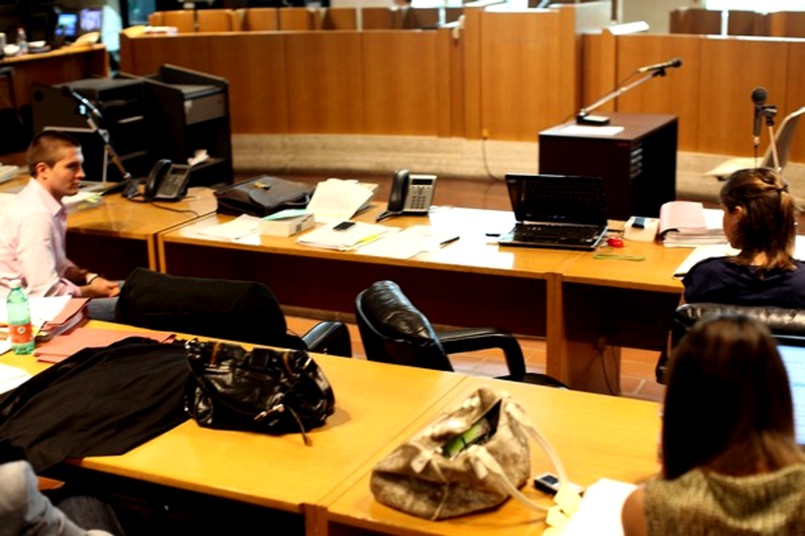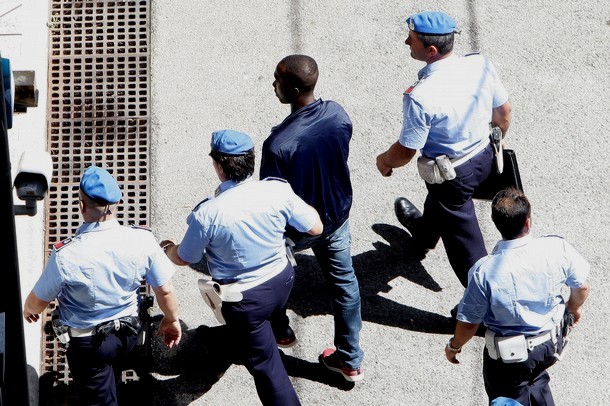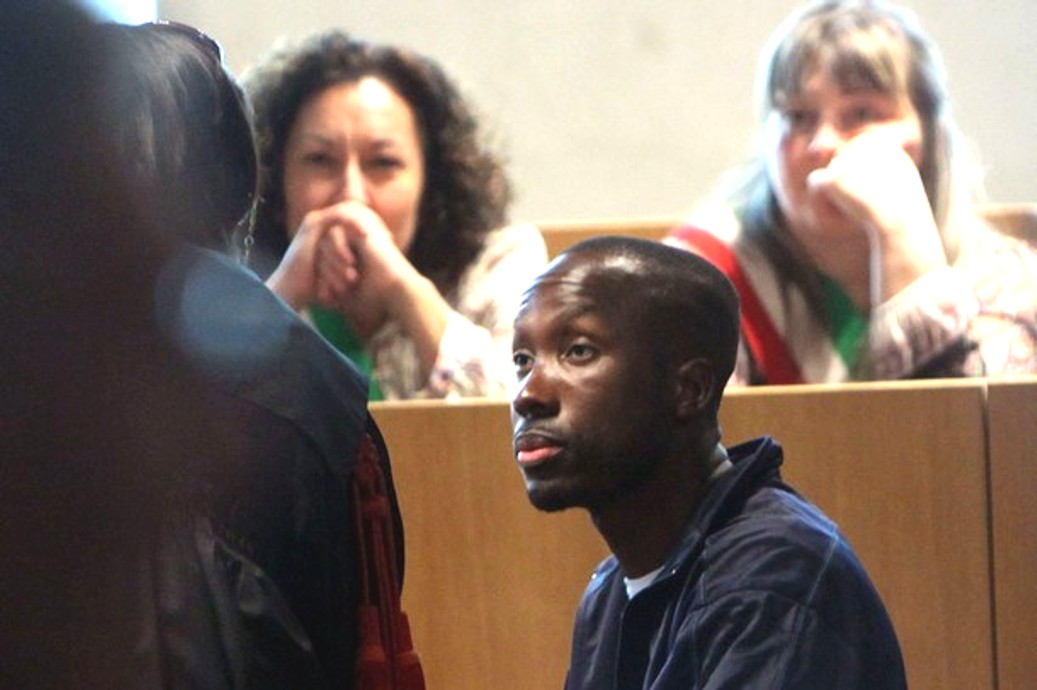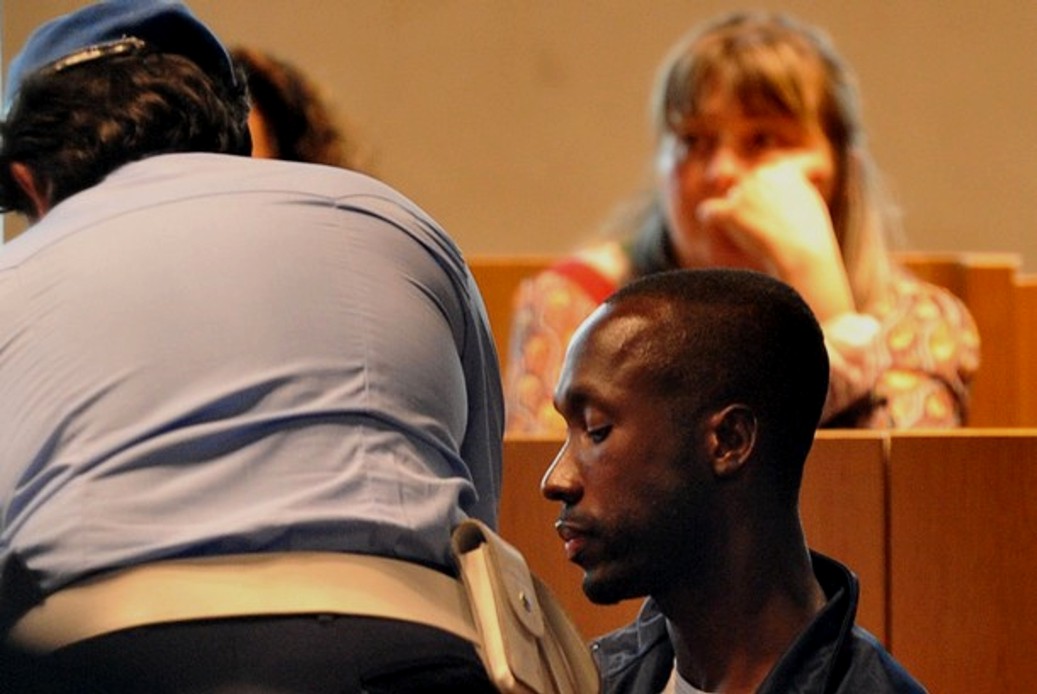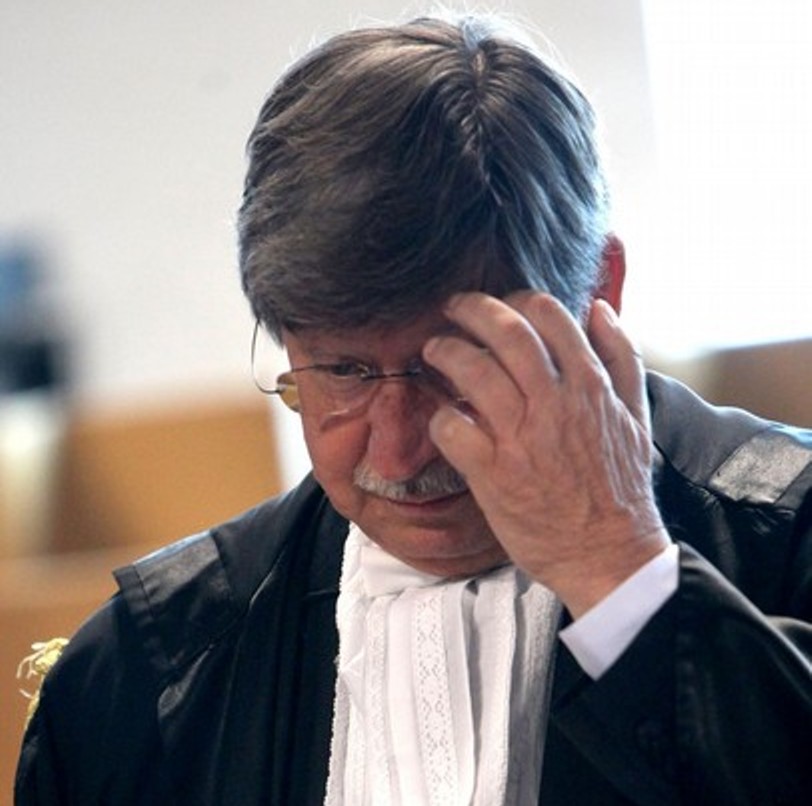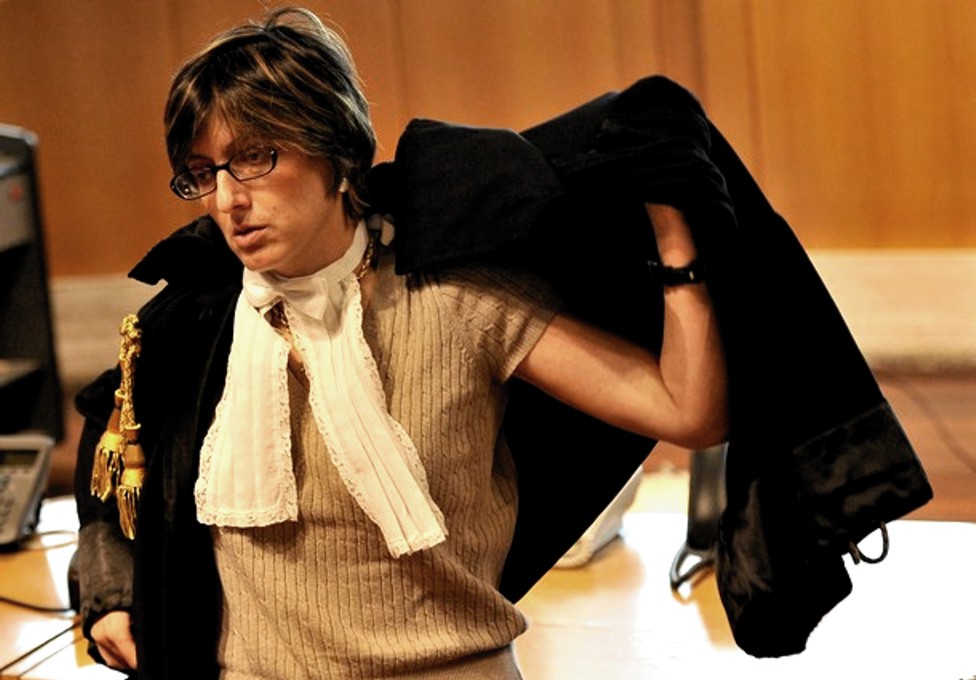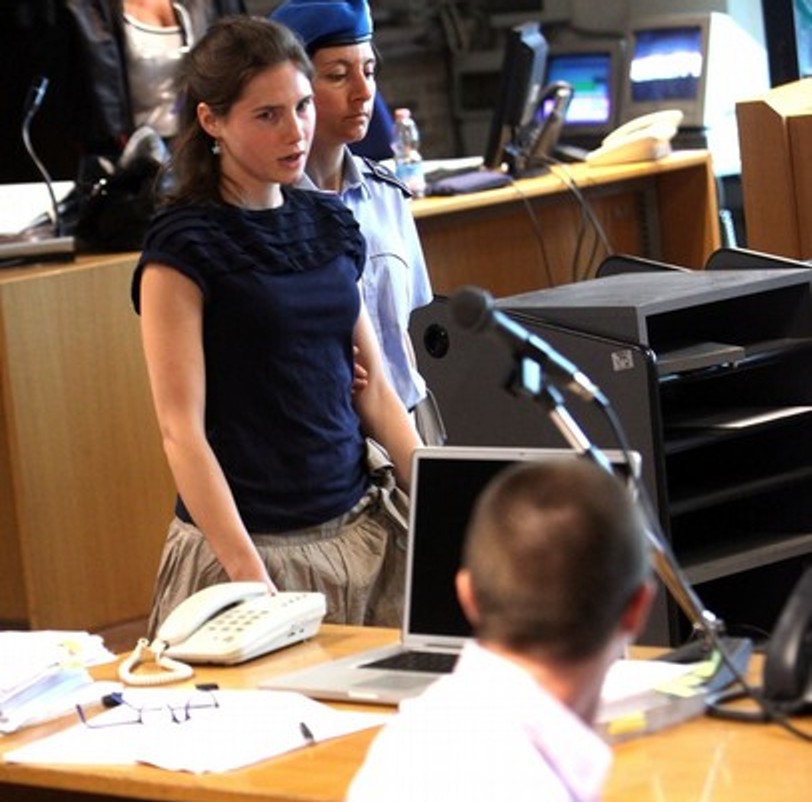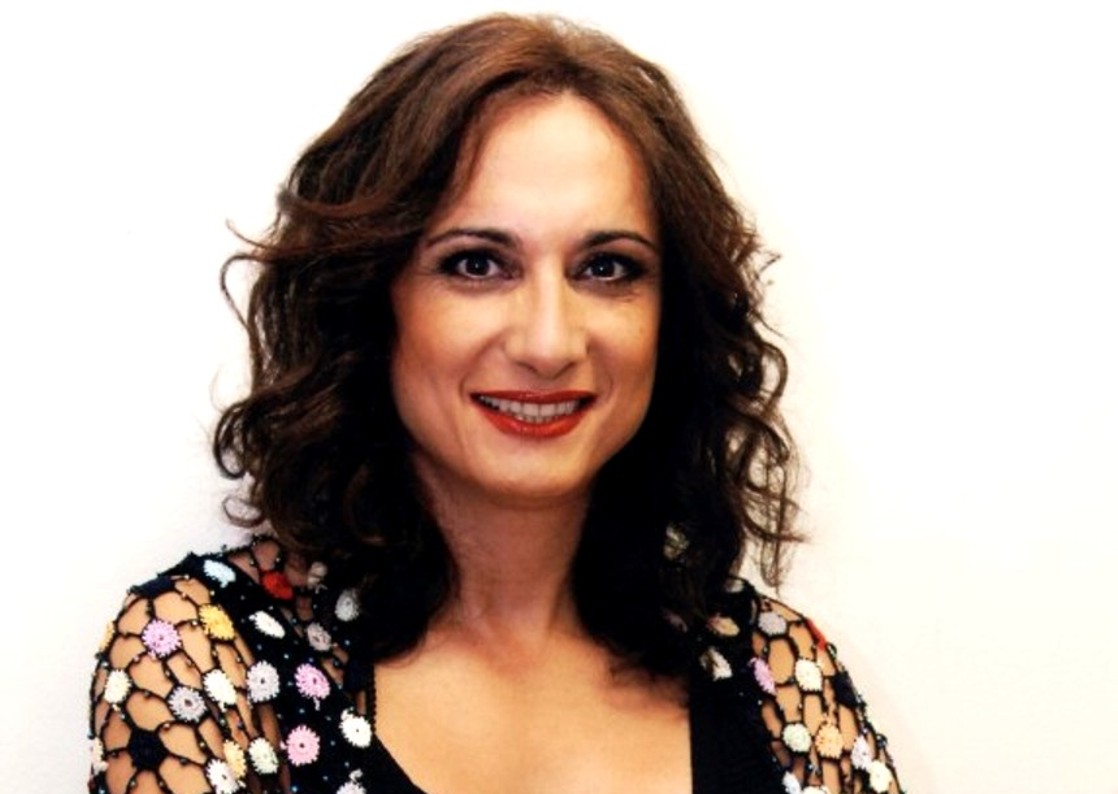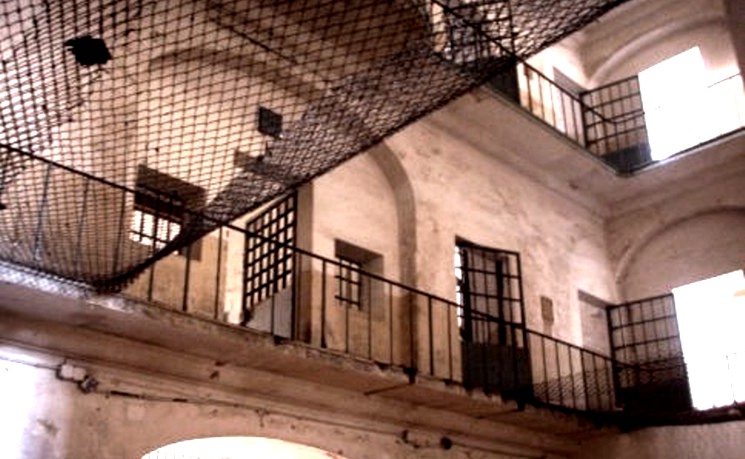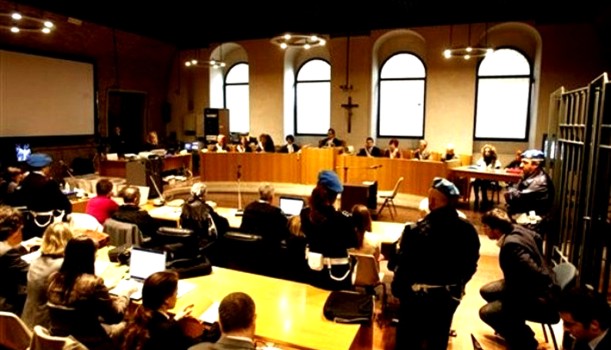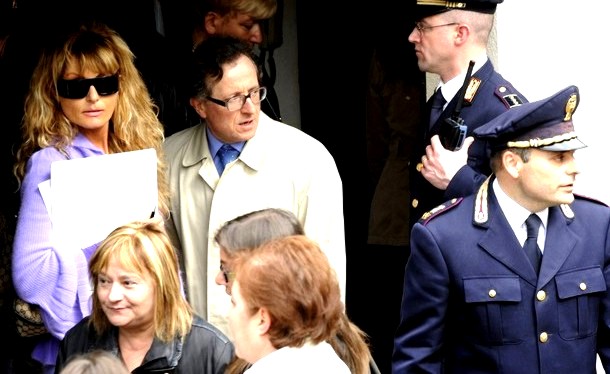
Headsup: Disney's Hulu - mafia tool?! First warning already sent to the Knox series production team about the hoaxes and mafia connections. The Daily Beast's badly duped Grace Harrington calls it "the true story of Knox’s wrongful conviction of the murder of her roommate". Harrington should google "rocco sollecito" for why Italians hesitate to talk freely.
Monday, June 27, 2011
Seen In The Court Today: The Appellants, Main Witness, Prosecutor, Defense Counsel
Posted by Peter Quennell
30-Plus Minute Video By Perugia’s Umbria24 TV Of Rudy Guede In The Courtroom
Posted by Peter Quennell
All in Italian. This is a video of the press TV feed in the press room which is allowed.
Rudy Guede For The First Time Sort Of Accuses Knox And Sollecito Face To Face
Posted by Our Main Posters
1. Potentially A Huge Day
Tension was really fraught. Everybody involved in the appeal and everybody watching in Italy knew this could be THE day.
Guede had recently lost his final Cassation appeal and in a very hard-line ruling Knox & Sollecito had also been associated with the crime.
He was at this appeal hearing as a prosecution witness, because he had written a letter to the prosecution heatedly denying the claims of a former cellmate, Alessi, that he had said Knox and Sollecito did not attack Meredith with him, another two had.
With seeming nothing to lose, Guede could both deny Alessi’s claim and definitively point the finger of blame at the pair, and thus all three would remain locked up for many years.
2. How The Day Actually Went
Despite a turbulent day in court this was not a shapeshifter event. The problem was that Guede was far too nervous to testify.
He is not normally nervous, but it is rumored that the name of Sollecito’s mafioso Uncle Rocco might have been been whispered in his ear.
So his prison letter was read out for him by the prosecution, and it did include this.
This splendid, marvelous girl was killed by Raffaele Sollecito and Amanda Knox.
Then Sollecito lawyer Bongiorno grew increasingly frustrated in attempting a cross-examination, and Guede ended up barely saying a word. The letter alone is rather diminished evidence.
3. Duncan Kennedy for The BBC
See this on the BBC website by Duncan Kennedy.
Amanda Knox and her ex-boyfriend did kill Meredith Kercher, a man who was also convicted of the 21-year-old’s murder has told an appeal court.
After Rudy Guede confirmed he believed the US student killed her British housemate, Knox jumped to her feet saying she was “shocked and anguished”.
The hearing in Perugia is the first time that all three defendants have given evidence on the same day.
Knox, 23, and Raffaele Sollecito, 26, are appealing their convictions.
Child killerMiss Kercher, of Coulsdon, Surrey, was found with her throat cut at her Perugia flat after what prosecutors claimed was a sex game taken to the extreme.
Knox is serving a 26-year sentence for Miss Kercher’s murder while her Italian co-defendant and ex-boyfriend, Sollecito, was sentenced to 25 years.
Guede told the court that claims by a fellow prison inmate that he thought Knox and Sollecito were innocent were not true. He said he never made that claim to the inmate.
On 18 June, convicted child killer Mario Alessi told the appeal Guede had confided that Knox and Sollecito were innocent.
According to Alessi, Guede said he and a friend went to the house Miss Kercher shared with Knox with the intent of having sex with Miss Kercher and that when she refused, the scene turned violent and his unnamed accomplice slit her throat.
Drug-dealer Guede was jailed for 30 years for the sexual assault and murder of Miss Kercher after a separate fast-track trial. His sentence was reduced to 16 years on appeal.
Guede was in the witness stand as a letter he had written in response to Alessi’s claims was read to the court on Monday.
“This splendid, marvellous girl was killed by Raffaele Sollecito and Amanda Knox,” the letter said.
Guede has previously admitted being in the house at the time of the murder, but denies involvement in Miss Kercher’s death.
After cross-examination by the defence, Guede said he had always believed Sollecito and Knox were behind the murder.
“I’ve always said who was there in that house on that cursed night,” he told the court.
Knox stood up after Guede’s evidence and denied his claims.
“The only time that Rudy Guede, Raffaele and I were in the same space has been in court. I’m shocked and anguished.
“He knows we weren’t there and have nothing to do with it,” she said.
Sollecito said Guede was always talking “about a shadow that could be me and a voice that could be Amanda’s… we’ve been fighting shadows for four years. Our lives have been destroyed in a subtle and absurd way.”
Speaking before Monday’s hearing, Knox’s mother Edda Mellas told reporters she hoped that Guede would have the “integrity to stand up and tell the truth”.
She said her daughter was “always very anxious and nervous but I think she’s glad things are moving along. She feels things are going well,” but that it is, “hard to get too hopeful, especially after the first trial.”
Two other witnesses were called to counter claims made by another defence witness, a member of the Mafia named Luciano Aviello, who had told the court earlier this month that his brother - who is on the run - had killed Miss Kercher during a botched burglary.
The two witnesses - two inmates at the same prison as Aviello - testified that Aviello had said he had been contacted by Sollecito’s defence team to stir up confusion in the trial in exchange for money.
Witness Alexander Ilicet said Aviello had wanted the money for a sex-change operation.
4. Andrea Vogt For The Seattle PI
See this in the report in the Seattle PI by Andrea Vogt.
As if the appeal wasn’t bizarre enough, two convicts were called by the prosecution as counter witnesses Monday to contradict several inmates called by the defense earlier this month.
They maintained they had overheard in prison conversations about a plot among other inmates to testify in exchange for money and benefits, such as reduced prison time.
The person they heard was arranging things, they said, was Sollecito’s attorney, Giulia Bongiorno, who heads up Italy’s parliamentary justice committee.
She forcefully denied the corruption accusations in the break afterwards and vowed to file charges and take legal action against her accusers.
One claim by the inmates was that Bongiorno offered a sex change operation to Luciano Aviello. It would be helpful if some of this if it exists emerged on tape. What possible reason would they have to lie?
5. And So To The Bottom Line
Along with Judge Hellman’s increasingly evident bias, and the smoke being blown over the DNA, and the Sollecitos and Bongiorno not (at least not yet) investigated by the judge for alleged witness bribes, not to mention Uncle Rocco’s power to alarm even by whispered mention of his name, the Knox and Sollecito defenses are down, but not yet for the count.
6. And A Footnote On The Kabuki Dance
This for the first time on Guede’s side (but not on Knox’s or Sollecito’s side) crosses a public boundary between the three.
The Italian lawyer Cesare Beccaria explained it thus..
Saturday, June 25, 2011
If Rudy Guede Testifies On Monday As He Might, It Could Be Game Over For Sollecito And Knox
Posted by Peter Quennell
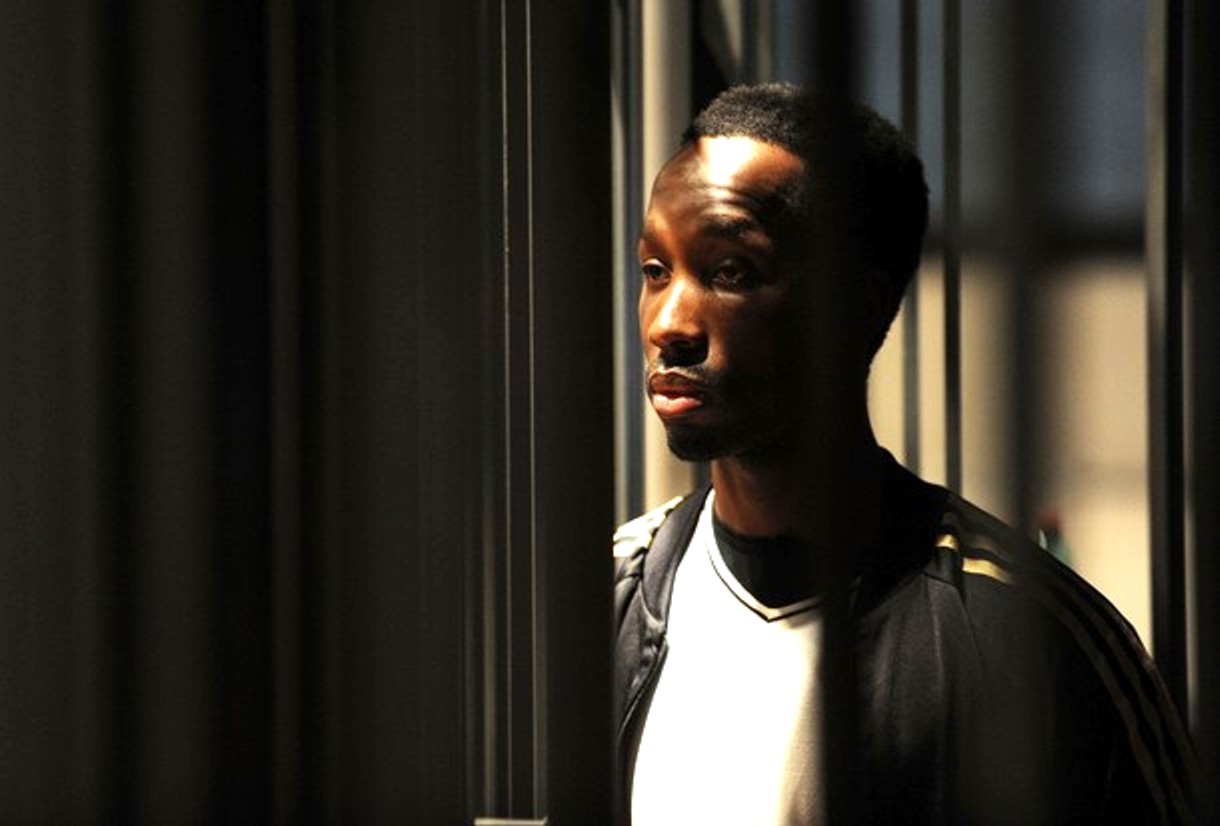
Rudy Guede might be compelled by the judge and prosecution on Monday to testify at length. He does not seem to have a legal reason not to as the Supreme Court set his sentence in stone.
He may of course really want to. Guede seems tired of being painted as the lone wolf or the wolf with two other accomplices.
In March last year he was decidedly ticked off when Mario Alessi began quoting or misquoting his claims about involvement. Here is the public letter he issued at the time, which inspired Mignini and Comodi to go interview him.
Guede’s letter to News Mediaset translated by TJMK poster Tiziano.
The complete text of the letter written by the Ivory Coast man.
Viterbo 07/03/2010
As usual in this beloved beautiful country of ours, there are many dishonest people given over to lying. And there are likewise those who give these people a voice without the slightest questioning of their consciences, whether it’s worth the trouble of giving space to certain conjectures.
In recent days the only things I have heard have been blasphemous insinuations about me; baseless gossip which has done nothing other than harrying, hither and thither, TV news channels, even though for reasonable people it is the pure invention of a wicked mind.
It must be said that all I have heard in recent days in the media, about what has been falsely stated by this foul being by the name of Mario Alessi, whose conscience is nothing but stinking garbage, are purely and simply the ravings of a sick and twisted mind, his ravings are the dreamed-up, untrue declarations of a monster who sullied himself with a frightful murder in which he took the life of an angelic little human being, as is known throughout Italy. This fellow, now, is telling lies about things that I never said to him and (other things) that I never said, things that don’t exist either in this world or the next.
To his ““ or rather their- rotten declarations, it’s my intention to put in black and white that I never confided in this disgusting creature, since moreover that I’ve got nothing to confess or anything else (to say), and everything that I had to say I have already said to the judges and I will go on shouting and fighting while I am still alive, until the truth itself and justice itself prevail over such lies, and even less did I speak one to one or together with other people or with other inmates about my trial affairs, and if I had ever had something to say, don’t you believe that I would have talked about it with my lawyers? Giving rise to and giving credit to what is a blasphemous statement made by a sick mind, to a monster who had no pity for a child.
With this latest scenario, which my lawyers, my family and I are now used to, from this latest person, the monster Alessi, I hope that Italians and the rest of the world realise that they are dealing with pigs, pigs which stink of the slime of falsehood, but which, not withstanding everything, go around showing their faces and suffocating people with their fetid lying.
Like their umpteenth scenario which does nothing more than give me the strength and the awareness to struggle more than ever, so that the truth that they want to hide is revealed for everyone to see.
As far as I’m concerned, (I have) the serenity and the calm of complete peace of mind, as a person who does not parade this unfair suffering, but who trusts in justice and in the good sense of Italians.
And finally I wish that sooner or later the judges will recognise my complete non-involvement in what was the horrible murder of the splendid, magnificent girl who was Meredith Kercher, by Raffaelle Sollecito and Amanda Knox.
Guede Rudy
See that final paragraph? It seems likely that he explained as much to Mignini and Comodi when they interviewed him in March 2010 in Viterbo (nothing has ever been released about what he said) and on Monday Judge Hellman could press him for proofs.
Past posts worth reading in this context are this one on his rather sad growing up and this one on the Supreme Court’s reasons for rejecting his final appeal, stating that three people had to have done it.
Also this one on one of his online conversations from Germany in 2007 with a Perugia friend, kindly translated by a PMF team.
Giulia Bongiorno’s Next Super-Witness: The Apple Of Her Witness Luciano Aviello’s Eye?
Posted by Peter Quennell
1. Anti-Aviello Testimony
This above is former Italian politician Vladimir Luxuria who, despite appearances, is fully male.
Testifying for the prosecution today, several rather convincing fellow-inmates have now contradicted defense witness Luciano Aviello’s 18 June testimony that his brother and one other had murdered Meredith.
Here is their claim. Defense counsel Dalla Vedova’s and Bongiorno’s “super witness” Luciano Aviello had told his fellow inmates that he wanted a sex change operation so he could end up looking like Luxuria.
This operation was to be paid for with money he claimed Bongiorno was offering for his false testimony to help RS and AK.
Giulia Bongiorno ended up outraged, and threatening lawsuits at this testimony, which she claimed was false (the paying of the money bit).
We are told an investigation will be started which may affect whether Bongiorno can stay on the Sollecito team.
[Added: yes, a month later we were told an investigation was under way.]
2. Bongiorno’s Other Problems
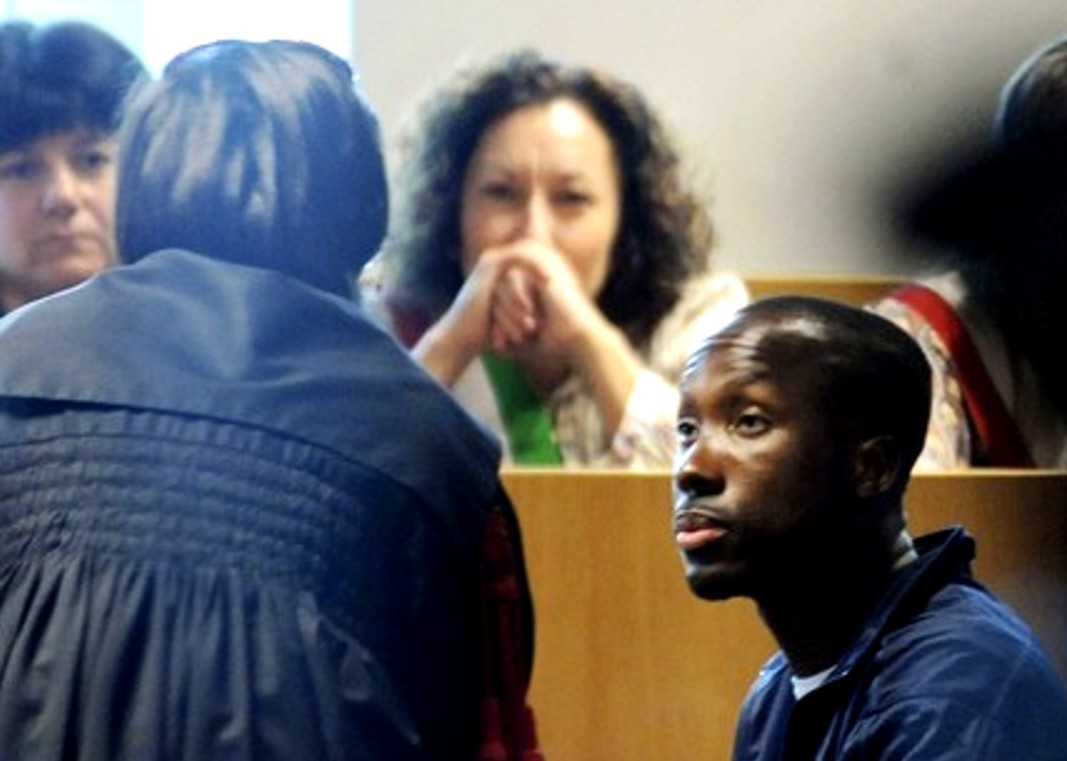
Above, a juror is grinning at Giulia Bongiorno’s frustration while Rudy Guede stonewalls her.
At various points in the trial and appeal she has dropped the ball in spectacularly goofy ways.
Bongiorno disappeared from the trial court late in 2009 for weeks with no explanation. She next appeared with a baby in her arms.
This morning she was sputtering to Judge Hellman that she only found out today about Rudy Guede’s letter - the letter reproduced in full in in this post which we translated into in English a full year ago.
She tried to have it excluded.
Here is another of Bongiorno’s sundry public disasters. She had claimed that an ex-burglar would climb into Filomena’s bedroom - but he never made it above eye-level with the window-sill.
In fact in three and a half years NO climber has ever made it through that window, though one or two did break in the far more logical way - via the hard-to-see and easy-to-climb rear balcony.
We do look forward to Giulia’s suit against the inmates. She has promised such suits often before.
Perhaps they will all arrive in a bunch?
Thursday, June 23, 2011
Conspiracy Theorists Attempt A Hijacking Of Rachel Sterne’s “Ground Report” And Readership Plummets
Posted by Peter Quennell

Rachel Sterne is attempting to help Mayor Bloomberg of New York to put the city government’s business across online in a neutral, credible and well-informed way.
Her own website, Ground Report, is an increasingly poor advertisement for her management skills. See the Alexa figures below. Readership of Ground Report is right now less than 100,000 in the world.
TJMk has several times beaten that ranking, and it may soon do so again. That is dangerously far away from being commercially viable, which for this kind of site means being in at least the top 10,000.
Worse, as the chart below shows, Ground Report’s readership has dropped FIFTY PERCENT since the Knox conspiracy theorists started targeting it with inaccurate, misleading and personally vicious posts daily.
Ground Report competes for the same eyeballs as the Huffington Post (70th in the world), Technorati (948) and Gather (2,231). Those smart and well-managed sites minimize attempted hijackings, ensure some sort of balance, and encourage robust commenting by readers who know raw truth when they see it.
Here on Ground Report are loopy new articles by Grace Moore and Bruce Fisher which should never have appeared. They are highly misleading and wildly at variance with the real facts. The Huffington Post would never have accepted such crap.
Bruce Fisher, a real Knoxaholic, is famously at sea on the hard evidence, and he is subjected to almost daily ridicule on the PMF forum for his pretentious wrong-headedness. He was previously kicked off both Technorati and Gather for defamatory posts against any messengers who objectively explain the hard realities of the case. Smart moves by Technorati and Gather.
Grace Moore flatly claims that Rudy Guede did it alone. Really?! How laughable.
The Micheli court and Massei court and Supreme Court of Italy have ALL already ruled that this was quite impossible. Two others were definitely there too. That is precisely why the defenses were putting convicted perps on the stand last Saturday - to try to prove Knox and Sollecito were not those two others.
Conspiracists are rather like sucker fish, which always cause the death of their hosts. Withstanding conspiracists desperate for an online home and existing audience when their own websites tank really is Group Blogging 101.
So. Good luck in withstanding the attempted hijacking of your website, Rachel Sterne. Truth in governance and accurate reporting do count.
Monday, June 20, 2011
Repeat of March 2010 Post: Guede Denounces Alessi, Blames Knox And Sollecito For Meredith’s Murder DRAFT
Posted by Peter Quennell
Guede will be required to testify on June 27. This is a repeat of Tiziano’s post of 12 March last year. At this point, Mario Alessi had made his claims to Sollecito’s lawyers at Viterbo Prison about Guede telling him he murdered Meredith with two others. And Rudy Guede had issued a heated hand-written rejection, denying this, ridiculing Alessi, and naming Knox and Sollecito as the murderers. Subsequent to this post, Prosecutors Mignini and Comodi travelled to Viterbo and interviewed both Alessi and Guede. This letter was Guede’s last major statement on the subject.
Please click here to read Rudy Guede’s hand-written letter from Viterbo Prison (above) in Italian.
Below is our translation of the letter as posted by TGCom.
Rudy Guede was obviously provoked into putting his version of events out by the claim of Alessi (see video at bottom of this post) that he had a colleague with him on the night, and also by the finding of the judges in the Dispositivo that he was the prime instigator.
The complete text of the letter written by the Ivory Coast man.
Guede’s letter to News Mediaset.
Viterbo 07/03/2010
As usual in this beloved beautiful country of ours, there are many dishonest people given over to lying. And there are likewise those who give these people a voice without the slightest questioning of their consciences, whether it’s worth the trouble of giving space to certain conjectures.
In recent days the only things I have heard have been blasphemous insinuations about me; baseless gossip which has done nothing other than harrying, hither and thither, TV news channels, even though for reasonable people it is the pure invention of a wicked mind.
It must be said that all I have heard in recent days in the media, about what has been falsely stated by this foul being by the name of Mario Alessi, whose conscience is nothing but stinking garbage, are purely and simply the ravings of a sick and twisted mind, his ravings are the dreamed-up, untrue declarations of a monster who sullied himself with a frightful murder in which he took the life of an angelic little human being, as is known throughout Italy. This fellow, now, is telling lies about things that I never said to him and (other things) that I never said, things that don’t exist either in this world or the next.
To his ““ or rather their- rotten declarations, it’s my intention to put in black and white that I never confided in this disgusting creature, since moreover that I’ve got nothing to confess or anything else (to say), and everything that I had to say I have already said to the judges and I will go on shouting and fighting while I am still alive, until the truth itself and justice itself prevail over such lies, and even less did I speak one to one or together with other people or with other inmates about my trial affairs, and if I had ever had something to say, don’t you believe that I would have talked about it with my lawyers? Giving rise to and giving credit to what is a blasphemous statement made by a sick mind, to a monster who had no pity for a child.
With this latest scenario, which my lawyers, my family and I are now used to, from this latest person, the monster Alessi, I hope that Italians and the rest of the world realise that they are dealing with pigs, pigs which stink of the slime of falsehood, but which, not withstanding everything, go around showing their faces and suffocating people with their fetid lying.
Like their umpteenth scenario which does nothing more than give me the strength and the awareness to struggle more than ever, so that the truth that they want to hide is revealed for everyone to see.
As far as I’m concerned, (I have) the serenity and the calm of complete peace of mind, as a person who does not parade this unfair suffering, but who trusts in justice and in the good sense of Italians.
And finally I wish that sooner or later the judges will recognise my complete non-involvement in what was the horrible murder of the splendid, magnificent girl who was Meredith Kercher, by Raffaelle Sollecito and Amanda Knox.
Guede Rudy
Below: Alessi’s statement at Viterbo Prison to Raffaele Sollecito’s defense team. Warning: this very self-serving statement by Alessi is graphic and offensive, as well as, in our view, almost certainly untrue.
Rudy Guede will be interrogated on the claims in this statement today Friday by Mr Mignini and Ms Comodi at Viterbo Prison. There could be news coming out of this interrogation later today.
Sunday, June 19, 2011
The Massei Sentencing Report For Knox And Sollecito: Part 1 Of A Summary In 4 Parts
Posted by Skeptical Bystander
Why This Long Summary
The full Massei Report can be found here.
The wiki page controversy surrounding the murder of Meredith Kercher rages on in a tiny corner of the online universe, here is our own contribution to the debate.
It is a 4-part summary of the Massei report, the document that sets forth and explains the Court’s reasons for unanimously convicting Amanda Knox and Raffaele Sollecito for their role in the murder of Meredith Kercher, Knox’s roommate, after a long, thorough and fair trial.
Please click here for more
The Massei Sentencing Report For Knox And Sollecito: Part 2 Of A Summary In 4 Parts
Posted by Skeptical Bystander
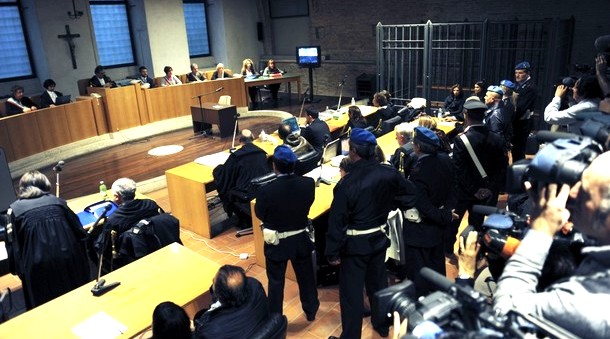
The full Massei Report can be found here. Continuing on with our summary:
4. Morning of November 2
Accounts of the events of the morning of 2 Nov do not agree. According to Knox’s statement, she and Sollecito slept until around 10-10:30 am.[67] After a while, she decided to go back to her house to take a shower and change her clothes, and to fetch a mop to clear up some water from a leaking pipe in Sollecito’s kitchen.[65] Her intention was that when she returned they would leave for a planned trip to the nearby town of Gubbio.[70]
When she arrived at her apartment, she was surprised to see that the front door was open. She entered the house, leaving the door open in case it had been deliberately left ajar by one of her flatmates, who might have gone out briefly, to get some cigarettes for example. She then went to her own room, undressed and went into the bathroom that she shared with Meredith. She took out her earrings and cleaned her ears - a regular necessity because the piercing in one ear had become infected. She noticed drops of blood in the sink, and thought this strange but continued to take a shower. Getting out, and not having remembered her towel, she decided to use the bath mat to shuffle into her own room. At that moment, she noticed the blood stain on the mat but thought it might be from some menstrual problem that hadn’t been cleaned up.[70]
Having returned the bathmat, she put her earrings back on, brushed her teeth, dressed in clean clothes and then went in the other bathroom (the one used by Romanelli and Mezzetti) and dried her hair with their hairdryer. She then noticed that there were feces in the toilet, which was strange as Romanelli and Mezzetti were very clean. She left her apartment, locking the front door, and went back to Sollecito’s, where they made breakfast and she told him what she had seen.[70]
In contrast to this account, forensic examination of Sollecito’s computer showed that it had been used for about half an hour from 5:32am to listen to music. After this, he turned on his mobile phone and, at 6:02 am, received an SMS message which had been sent to him by his father the previous evening when the phone was switched off. Phone records also confirmed a call made at 9:30am to Sollecito by his father. There was no mention of any of this activity in Amanda’s statement.[82]
According to the testimony of Marco Quintavalle, the owner of a small supermarket, he opened his shop at 7:45am on the morning of November 2 and almost immediately a young woman, whom he identified as Amanda Knox, went into the store department that had groceries, detergents and toilet paper on sale. He saw her leave again but did not know if she bought anything. Quintaville did not present this information to the police until some months after the crime and explained that, although he had previously been questioned about the morning after the murder, he had not been specifically asked about Knox. Another of the shop’s employees stated that she had not seen Knox in the store.[83-84]
The court highlighted the discrepancies between Knox’s account and the evidence of the computer and phone records and the testimony of the shop owner. It also doubted the credibility of Knox going back home to change her clothes, take a shower and fetch the mop to dry the floor. Since Knox and Sollecito had planned a trip to Gubbio that morning, she could well have brought the clothes with her that would be needed. It was also noted that Knox had already showered and washed her hair at Sollecito’s house, the previous evening: there was no obvious need for her to repeat those actions and, if there were such a need, there was no reason why she couldn’t do so at Sollecito’s. Fetching the mop to dry the floor was also deemed to be scarcely credible, considering that Sollecito employed a cleaner and, in any case, everything needed to clean up some water was already there.[85]
What is certain is that, around midday, Knox called Filomena Romanelli to say she had arrived at the apartment and had found the door open: she had taken a shower and it had seemed to her that there was some blood in the apartment. She said that she was going to Sollecito’s place but did not know the whereabouts of Meredith. Romanelli rang Knox back and Knox (now at Sollecito’s) told her that the window in Romanelli’s room was broken, everything was in a mess, and that she should come back home.[30]
Knox and Sollecito went back together to the house in Via della Pergola. According to their accounts, they looked in Romanelli’s room where there had apparently been a burglary, and checked the other rooms, but found nothing missing. They were worried that Meredith’s door to her room was locked and, when she was called, there was no answer. Sollecito made an attempt to force open Meredith’s door (described by the court as a ‘timid’ attempt, given that it was easily forced open later).[31] After that, they left the house, partly to look at the broken window from the outside.
Earlier that morning, two mobile phones had been discovered in the garden of a house located in Via Sperandio, a short distance from 7 Via della Pergola (the shortest route would be distance of about 5-7 minutes on foot, according to one witness).[25] The owner of the house had contacted the Communcations Police with regard to a telephoned bomb threat which she had received and then discovered the two phones. One of the phones was registered to Romanelli (although both were in fact Meredith’s phones - one given to her by Romanelli for use in italy).[26][30]
The Communications Police traced Romanelli’s address and arrived at the girls’ apartment some time between 12:30pm and 1pm. Outside the house, they found Amanda Knox and Raffaele Sollecito ““ who said that they were waiting for the carabinieri, whom they had called because they had been away for the night and had come back to find the entrance door open and then a window broken.[28]
Romanelli, her friend Paola Grande and their boyfriends, Marco Zaroli and Luca Altieri arrived around 1pm.[28] Romanelli made a quick check of her room, discovering that, although it was in a complete mess with the windowpane broken and clothes thrown around the floor, nothing was missing.[31] Nonetheless, she was concerned that the front door had been found open, bloodstains had been found in the small bathroom, and there was no news of Meredith. Furthermore, Meredith’s bedroom door was locked.[31]
The significance of this fact subsequently became a point of disagreement, with Knox saying that even when she went to the bathroom for a shower Meredith always locked the door to her room (the fact that she said this being confirmed by Zaroli and Altieri). Romanelli, on the other hand, said she was aware of only one occasion when the door had been locked and this was when Meredith had returned to England for a few days.[31]
The Massei report notes Knox’s apparent lack of concern at the locked door, both in the presence of the Communications Police and in her earlier telephone conversation with Romanelli. This was at odds with an email that Knox sent to her friends and family a few days after the murder (November 4, 2007) in which the locked door acquired a central importance and Knox described herself as “panicking” when she first discovered it. Massei concludes that panic at the locked door would be a logical reaction if Knox had been uninvolved in the murder, but according to Romanelli and the Communications Police, there was no such panic.
Knox and Sollecito, in fact remained in the living room, some distance away from Meredith’s room, while Romanelli and her friends were so concerned that they decided to force the door open. One of Romanelli’s friends broke down the door and the bloody body of Meredith Kercher was found.[32] The Communications Police sealed the area and called the Carabinieri, who arrived a short time later.[33]
5. Pathology: Injuries, time and cause of death and Conclusions
Massei observes that the injuries Meredith Kercher sustained were the subject of intense analysis and speculation in the courtroom, yet his summary and conclusions are clear and concise. Many of Meredith’s injuries appear to have been caused by the actions of restraining, whereas some were obviously inflicted by a knife or knives and showed great diversity in both dimensions and overall harmfulness. Massei found that one point was particularly significant: the knife wounds from the attack to Meredith’s neck came from both the right and the left sides.[371]
Massei believes Meredith’s injuries lie at the heart of the debate over the single attacker versus the multiple attacker scenarios. The hypothesis of a single attacker requires that the single attacker continually modify their actions, first by exercising a strong restraining pressure on her, producing significant bruising, and then for some reason switching to life threatening actions with a knife, thereby changing the very nature of the attack from that of subjugation to that of intimidation with a deadly weapon, and finally to extreme violence by striking first from the right penetrating to a depth of 4cm (1.5 inches) and then from the left to a depth of 8cm (3 inches) into the neck.[371]
Massei describes the first knife blow coming from the right by saying that it was apparently halted from going any deeper by hitting the jawbone. The Court considered that this blow was an effort to force Meredith to submit to an action against her will. The Court also considered that the penetrating knife wound from the left was preceded by the action of running the knife over the surface of the skin on the same part of Meredith’s neck, just a few centimeters below the eventual strike zone where the serious, deeper second wound was inflicted.[371]
What surprised Massei about Meredith’s wounds was that in spite of all the changes in approach during the attack she somehow remained in the same vulnerable position, leaving the same part of her neck fully exposed to an attacker. If this were a solo attacker then this person released a firm restraining grip on Meredith to somehow bring a knife into play, then striking her first from the right and then switching the knife-holding hand to somehow float a knife in an intimidating manner across her neck on the left, before finally stabbing her in that same location on the left with a final debilitating blow.[371-372]
Massei concludes that throughout the attack Meredith remained virtually motionless, and he cites the almost nonexistence of defensive wounds on other parts of her body in comparison to the number, distribution, and diversity of impressive bruises and wounds to her face and neck. Massei finds this disproportion to be a significant factor, particularly when considering Meredith’s physical and personality characteristics.[370,371]
Meredith’s physical build was described as being slim and strong; possessing a physique that would have permitted her to move with agility. In addition, Meredith was described as being athletic and one who practised football, karate, and boxing.[369] Therefore, the court found it unlikely that only one person performed the attack against her, and inevitable that several people had acted together against Meredith; a group who forcibly restrained Meredith in movement so that she could not defend herself in any way nor shield herself with her hands in order to avoid the repeated attacks to her neck.[371]
Meredith’s defensive wounds were found to be minimal and consisted of a 0.6cm (quarter inch) long superficial slice on the palm of her right hand showing only a trace of blood and another 0.6cm (quarter inch) slice on the second finger of her left hand, along with several highly superficial cuts to the fingertip of the index finger. Massei finds this remarkable considering that the normal and instantaneous human reaction to that first violent knife stab to the neck would have been to protect the area of attack, along with a strong desire to escape even if it meant receiving a blow to another part of the body. However, Meredith remained in the same standing position while continuously offering her exposed neck to the actions of the person(s) striking her, with the peculiar distinction of striking first from the right and then from the left. Massei believes that a scenario as such seemed inexplicable, unless one accepts the presence of more than one attacker who, as a group, forcibly restrained the athletic Meredith’s movements while intimidating and striking her from multiple angles.[369]
Massei also believes that evidence demonstrated Meredith was still dressed and awake when the attack began on her and that the violence against her could not have taken place as it did if Meredith were lying on her bed. Massei concludes that Meredith was sober and fully conscious since no traces indicating either the use of drugs or the abuse of alcohol were found; all of which, if present, might have contributed an inability to firmly resist an attack.[369]
Furthermore, Massei finds it impossible to imagine a scenario in which a single person could have removed the clothes that Meredith was wearing (shoes, pants and underwear) while inflicting the sexual violence revealed by the vaginal swab. Massei finds it highly unlikely that one person could have caused all of the resulting bruises and wounds cited above in addition to removing her sweatshirt, pulling up her shirt, and bending her bra hooks by force before finally tearing and cutting the bra. The actions on the bra alone, during which a small piece of material with hooks was cut off and thrown to the floor, were necessarily conducted from behind Meredith and required the attention of both hands of an attacker, and thus Meredith would have had her own hands free to attempt actions of self-defense.[370]
Massei concludes there was very little evidence of any defensive maneuvers on the part of Meredith, which to him was a strong indication that several attackers were present, each with a distribution of tasks and roles: either holding Meredith and preventing her from any significant defensive reaction, or actually performing the violent actions. Massei concludes that the rest of the body of evidence came in full support of such a scenario, recalling that a biological trace of Rudy was found on one of the cuffs of Meredith’s sweatshirt indicating a gripping in order to prevent any reaction. In drawing together all of the elements mentioned above, both circumstantial and forensic, Massei concludes that the diverse morphology of the injuries, their number, and their distribution mandated that the violence against Meredith was performed by multiple attackers.[370-371]
Summary of pathology findings
Massei describes the significant injuries discovered during the post-mortem examination and states that there were no noticeable injuries in the chest or abdomen areas, two areas of slight bruising on one elbow, small wounds on the hands indicative of a minimal defensive response, very slight bruising on the front of the left thigh, minor bruising on the front middle of the right leg, and a slight area of bruising just below the top of the head.[111-112]
Massei cites compelling evidence of recent sexual activity having the characteristics of non-cooperation on the part of the female participant. Non-spermatic biological material belonging to Rudy Guede was discovered during the course of a gynecological examination of the corpse. This, in conjunction with a distinct pattern of abrasions, was interpreted by the court as being strong evidence of sexual violence.[157-158]
The head and neck injuries were the most significant and included small spots inside the eyelids indicative of asphyxiation, a bruise to the cheek possibly caused by a knife point, bruising on the nostrils and trauma to the lips suggestive of silencing or suffocation efforts, biting injuries to the tongue, bruising and abrasions on the lower jaw indicative of a hard compression by hand, and neck swelling and hemorrhaging with pools of blood left inside the lungs as a result of two significant knife wounds.[111]
Dr. Lalli, the Perugia Coroner, who performed the autopsy on Meredith at the morgue of the Perugia Polyclinic, reported that the hyoid bone, located at the back of the tongue muscle had been “severed”.[145: Professor Torri quotes Dr. Lalli’s comment]
The most significant wounds Meredith sustained were inflicted by knife-stabs and thrusts occurring very quickly from the right and from the left, severing the right superior thyroid artery and the hyoid bone.[139] The largest of these was inflicted by a knife high on the left side of the neck near the jawbone which penetrated to a depth of 8cm (3 inches).[111]
Another significant knife wound, 4cm (1.5 inches) deep, was noted on the right side of the neck, above which were found superficial parallel scratches. The wound from the right crossed the path, inside the neck, of the wound from the left. The Court concluded that these knife wounds were made by single-bladed, pointed cutting tools and that Meredith’s injuries might be consistent with a virtually infinite number of instruments, provided they had a blade with only one sharpened edge that was not serrated.[111-113]
The Court held that it is self evident that should one conclude during forensic pathology investigations that a knife is not compatible with any of the wounds inflicted on the victim, it would be pointless to give that knife further consideration, including DNA testing.[166]
The experts and consultants who were examined during the course of the trial, taking into examination the various wounds present on the neck, did exclude the compatibility of Raffaele’s knife with the smaller stab wound inflicted on the right side of the neck, and the Court agreed. However, the Court did not agree with arguments that the knife confiscated from Raffaele’s flat was incompatible with the deep wound on the left. The Court concurred with expert testimony proclaiming that the knife presented by the prosecution as the murder weapon, with the DNA of both Meredith and Amanda on it (ie the “double DNA knife”), is clearly compatible with the large fatal neck wound.[169-173]
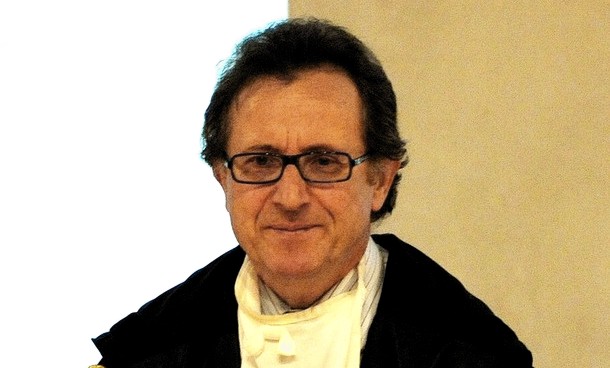
Cause of death
The Court found that the death of Meredith Kercher was asphyxia caused by the neck-wound which severed both the hyoid bone and the right superior thyroid artery. The severing of the hyoid bone opened Meredith’s airway directly through the skin to the atmosphere, and the severed right superior thyroid artery was the main source of the blood which asphyxiated her when she then inhaled blood directly through her severed airway down into her lungs.[162]
Time of death
In order to preserve the crime scene, a thorough examination of the corpse was not performed until approximately 11 hours after the body was discovered. Relying upon the criterion of body temperature and the influences of various other factors such as blood loss, the corpse being covered with a duvet, and other environmental conditions the time of death was initially placed approximately between 8:00 pm November 1, 2007 and 04:00 am November 2, 2007. An intermediate value for such a time range is considered of value, and the actual time of death was suggested by the coroner as being approximately 11.00 pm on November 1, 2007. The combined criteria of temperature, hypostatic stains, and rigor mortis all supported this range for the time of death, but for a variety of reasons were unable to accurately define a more narrow time of death range.[113-116]
Massei notes that the state of digestion of Meredith’s stomach contents provided significant additional information towards establishing a more accurate estimate for the time of death. Meredith’s stomach contents included apple, cheese, and floury fragments of the apple crumble she ate while visiting friends, which had not yet entered into her the small intestine. In addition, a piece of mushroom was also found in Meredith’s esophagus. This could not have been consumed during the meal with friends, which did not include mushrooms, since it was in a different less digested state.[115, 178-179]
Testimony during the trial established that an emptying of the stomach into the small intestine under typical conditions starts between two and four hours after the start of a meal. A complicating factor is that Meredith apparently ate additional food at home after her earlier meal which, according to statements made by the British friends of Meredith, occurred sometime between 6 pm and 8 pm. Nevertheless, it becomes possible to propose a time of death as being 3 to 4 hours beyond the time frame of the initial eating event: therefore, this could reasonably range between 9pm (around the time she arrived home) and midnight of November 1, 2007. This timeframe remains consistent with all other indicators. It is important to note that the beginning of the attack would have been a moment of tremendous stress for Meredith that may have arrested her digestive process. However, Massei notes that this, like many other variables concerning the behavior of the digestive tract, remains in the realm of speculation.[178-179]
The various consultants and experts heard in court regarding the time of death all emphasized the difficulty of establishing a precise time. Regarding time of death, there can be no doubt that Massei relied upon the evaluations of a variety of evidentiary sources, including the consideration that Meredith would not have been able to make any vocalizations following the final fatal stab wound to her neck, which lends importance to witness statements regarding when they may have heard a scream on the night of the murder. However, the Court concluded that testimony regarding the pathology alone made it possible to suggest that the time of death that was, in fact, within a range of tens-of-minutes either before or after 10:50 pm November 1, 2007.[131]
6. Forensic investigation
The forensic evidence included the analysis of DNA in various samples taken, of footprints revealed by Luminol, and of foot prints and shoe prints.
Meredith Kercher
The fatal wound was swabbed in order to obtain the profile of her DNA for comparison with other samples. [190] One of two swabs of her vagina produced genetic material, the DNA of the Y chromosome of Rudy Guede. [189] Samples taken from under her fingernails yielded only her own DNA. The court noted that her finger nails were very short and probably would not inflict significant scratches on an attacker. [190]
Rudy Guede’s Y chromosome was also found mixed with Meredith’s blood on Meredith’s handbag and on the left cuff of her sweatshirt.[192]
The Small Bathroom
Blood was found in seven locations in the small bathroom that Knox shared with Meredith. [192]
“¢ The Door Frame: blood was found on the right, inside door frame containing Meredith’s DNA. [192]
“¢ The Light Switch Plate: Meredith’s blood was also found on the light switch. [192]
“¢ The Sink: Blood was found in two places. There was dried blood near the faucet that had the DNA of Knox. [192] A streak from the left part of the sink toward the drain containing Meredith’s blood mixed with DNA of Knox.[192]
“¢ The Bidet: Meredith’s blood was found mixed with the DNA of Knox.[192]
“¢ The Toilet Lid: Meredith’s blood.[192]
“¢ Q-tip Box: Meredith’s blood mixed with DNA of Knox.[192]
“¢ The Bathmat: Three samples taken from the bathmat yielded Meredith’s blood.[192] The bloodstains on the bathmat were studied and compared with footprints taken of the right foot from Knox, Sollecito, and Guede, and found to be that of Sollecito. [351-355]
The Large Bathroom
Toilet paper and faeces were found in the toilet. Testing the toilet paper found the DNA of Rudy Guede.[192]
Traces Revealed by Luminol
Various surfaces were sprayed with Luminol, which fluoresces brightly when applied to blood. The fluorescence was then swabbed and tested for DNA. Nine traces were found; two were Meredith’s, three were Knox, and two were mixed DNA of Meredith and Knox.[281-286]
“¢ Romanelli’s Bedroom: One sample of Meredith, and one of Meredith’s blood mixed with DNA of Knox.[282]
“¢ Hallway: Three footprints matching, based on measurements, Knox’ right foot were found, two facing the exit, and one oriented toward the doorway of Meredith’s room.[247]
“¢ Knox’ Bedroom: Footprint of Amanda Knox’ right foot, also identified by measurements.[247]
Shoeprints
Shoeprints made in Meredith’s blood and visible to the naked eye led from Meredith’s bedroom to the exit, becoming fainter toward the exit. [193] These were determined to be incompatible with Sollecito’s shoe size 9, and to be compatible with a Nike Outbreak 2, size 11.[334-336]
Although the shoes were never found, a box for Nike Outbreak 2, size 11 was found in Guede’s apartment.[334]
A left shoe print was found on Meredith’s pillow, estimated to be between size 36 and 38.[342]
Knox wears a size 37.[343] A defense expert made a comparison of the sole pattern with Guede’s right shoe, and argued that the print could have been made by him. The court noted the conflicting theories without expressing a specific opinion,[343-344] and noted that Knox seemed to have been moving about the scene in her bare feet.[344]
Other Evidence
“¢ A small trail of drops of Meredith’s blood from the small bathroom to the kitchen/living room.[193]
“¢ A cigarette butt found in the kitchen had mixed DNA of Sollecito and Knox.[197]
“¢ A jack knife belonging to Sollecito was found to have the DNA of Sollecito and Knox, but no blood.[195]
The Court’s Analysis:
The defense did not contest the mixed DNA test results, but instead argued that they were irrelevant: that mixed DNA would be expected since Meredith and Knox lived in the same house and shared the small bathroom. [378] They suggested that Knox’s DNA could be exfoliated skin cells. Dr. Stefanoni (for the prosecution) testified that exfoliated skin cells are keratinized and contain no DNA. [202]
The court concluded that Knox’ DNA became mixed with Meredith’s blood from vigorous scrubbing of the hands and feet, and that this is how the mixed DNA sampled came to be found in the sink and the bidet.[279]
DNA testing cannot, by itself, determine when biological material has been deposited, or in the case of mixed DNA, which was deposited first or whether it was simultaneous. [211] However, the court noted that Knox told the court in her answer to questioning that the bathroom was clean when she left the house on the afternoon of November 1.[278]
The court concluded that Meredith’s killers had gotten blood on their hands and elsewhere on their bodies, and that they needed to clean off the blood. Accordingly, they tracked blood on their feet to the small bathroom, where Meredith’s blood was transferred to the doorframe and light switch plate when they turned the light on in order to use the bathroom.[279] Sollecito tracked Meredith’s blood into the bathroom, leaving a partial print of his right foot in blood.[379]
Knox was not wounded.[280] The trace of her blood on the tap was different in appearance from the mixed DNA samples, and was explained by her as having come from her own ear having been pierced. [280] The mixed trace in the sink and the bidet appeared to have been diluted with water, constituting a single trace placed there by Knox when she was cleaning Meredith’s blood from her hands and feet.[378]
The defense experts did not specifically attack the accuracy of the findings on the trace evidence revealed by Luminol.[285] Dr. Gino noted that a generic test for blood was negative on the sample, and that the DNA test was low copy number. She also noted that substances other than blood can cause Luminol to fluoresce.[282]
The court observed that there was an abundant quantity of Meredith’s blood on the floor of the bedroom to be tracked around the house.[279] The fact that DNA testing revealed the presence of genetic material in the samples indicates the presence of biological material that reacts with Luminol. The court said that attributing the fluorescence to fruit juice, rust, bleach, vegetables, etc. could not explain the presence of reactive trace in so many parts of the house, whereas the walking in blood and subsequent cleanup easily accounts for the findings.[283-285]
The defense’s “low copy number remark” was rejected because Dr. Stefanoni had testified that the sample had been processed according to standards and procedures necessary for international quality certification, and noted that the certification was granted by the international certifying body in 2009; the quality certificate was an acknowledgement of what already existed, and had already been done.[285] Further, the court noted that the criticisms of Dr. Gino and Dr. Tagliabracci were hypothetical, and all concerned specific findings and a small portion of the specimens.[285]
The footprint on the bathmat was partial, missing the heel. [339] Based on the dimensions of the big toe, the plantar arch, and the shape and location of various “bumps”, Inspectors Rinaldi and Boemia concluded that the print was made in Meredith’s blood by Sollecito’s right foot, that it was consistent with Sollecito’s wider foot and inconsistent with Guede’s longer, narrower foot, and well as being inconsistent with Knox.[339-342]
The measurements from the bathmat: big toe”“33mm wide, 39mm long. Metatarsus”“99mm wide, 55mm long. [339]
Footprints taken with printer’s ink resulted: Big Toe—Sollecito: 30mm wide, 37mm long. [339] Guede: 23mm wide, 43mm long. Knox: 22mm wide, 41.8mm long.[339] Metatarsus”“Sollecito: 99mm wide[339]
Rinaldi and Boemia used the so-called L.M. Robbins grid, which is marked in centimeters, lining the vertical axis with right-hand outline of the foot, and the horizontal axis with the tip of the big toe. [340] By comparing the samples with the bathmat, they concluded that the shape of Guede’s plantar arch and the alignment of his “bumps” could not be reconciled with the print on the bathmat, whereas Sollecito’s bumps align consistently between his sample and the bathmat. [340-341] The primary distinctions between Guede’s right foot and Sollecito’s are: the width of the big toe, the shape of the metatarsus, differences in the plantar arch, and the shape of the left side of the foot.[341]
Professor Vinci, Sollecito’s expert attempted to show that the foot print was actually that of Guede. He argued that the morphology of Sollecito’s foot was such that his second toe made no contact with the paper, but that a portion of the mark on the right side of the big toe print on the bathmat is actually from the second toe. He thus measured the big toe print as being 24.8 mm wide.[352]
The court rejected this theory. It noted that the photograph appeared to show the opposite of what was claimed, i.e., it showed the blood had been deposited as a single unit on a decorative flourish of the mat. Moreover, the court noted that, by comparison, Guede’s foot is generally longer and more tapered, and that the second toe print falls quite far from the big. [354] Finally, the court discounted the idea that Guede had ever been in his bare feet that evening. The visible shoe prints clearly showed that he walked directly from Meredith’s room, down the hallway, and out the door.[379]
The Massei Sentencing Report For Knox And Sollecito: Part 3 Of A Summary In 4 Parts
Posted by Skeptical Bystander
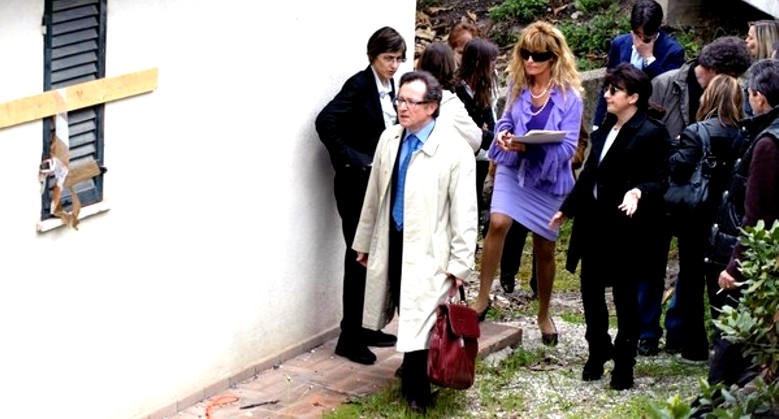
The full Massei Report can be found here. Continuing on with our summary:
7. Double DNA knife and bra strap
Exhibit 36: The double DNA Knife
Exhibit 36 is a 31 cm long knife with a 17 cm blade and a dark handle. It was seized from the kitchen cutlery drawer at Raffaele Sollecito’s home, located at 110 Corso Garibaldi in Perugia, on 6 November, 2007 when Chief Inspector Armando Finzi was ordered to perform a search of Sollecito’s residence. This exhibit is important because “Sample 36b” taken from a scratch on the knife blade yielded Meredith Kercher’s biological profile.
After putting on gloves and shoe coverings, Finzi and his team entered the home. They noted a strong smell of bleach. Opening the cutlery drawer, they saw a big, “extremely clean” knife. In Sollecito’s bedroom they found a second knife. The knives were bagged and sealed.[106]
Exhibit 36 was carried back to the police station, where it was placed in a box for shipping to the Polizia Scientifica in Rome. Dr. Stefanoni was the recipient of the box containing the knife in Rome. All parties testified that standard procedures were followed to avoid the risk of contamination.
On 4 November, 2007, Meredith’s roommates Filomena Romanelli, Laura Mezzetti, and Amanda Knox had been taken by the police to look at the knives in their kitchen at the apartment in Via della Pergola. Personnel from the Questura reported Amanda’s “severe and intense emotional crisis, unlike [the reaction of] the other two girls”.[292] This behavior was contrasted to Amanda’s behavior at Police headquarters two days earlier:
“This circumstance appears significant both in its own right and also when one considers that Amanda had never previously shown signs of any particular distress and emotional involvement (in the Police headquarters, on the afternoon of November 2, Meredith’s English girlfriends, Robyn Carmel and Amy Frost in particular, according to their declarations, had been surprised by the behaviour of Amanda, who did not show emotions).”[292]
Investigators’ attention was alerted to the Exhibit 36 knife because of Amanda’s inconsistent behavior. Later, police overheard a jail conversation between Knox and her parents on 17 November, when Knox said, “I am very, I am very worried about this thing with the knife ... because there is a knife of Raffaele’s ...”.[292]
Exhibit 36 thus became a central piece of trial evidence. The debate would subsequently be focused on two issues: The compatibility of the knife with the large stab wound in Meredith’s neck; and the reliability of the DNA analysis.
Considering the first of these points, although the knife blade is 17 cm long, the depth of the larger wound is just 8 cm . This “discrepancy” was the basis of defense efforts to discredit the knife as a murder weapon. The compatibility of the Exhibit 36 knife and the larger of Kercher’s wounds is addressed by Professor Bacci (see p. 121 of the Massei report). Professor Norelli maintains that “it is not said that a blade is always embedded (plunged into) the target right up to the handle; the blade may also go (in) only to a certain portion of its length, and not right up to its end”.[126]
It is noted that the movements of the victim may have played a part in determining the depth of the cuts. “If I insert a centimeter of the blade into the victim and the victim suddenly moves towards me, how much of the blade will be driven inside the body surface area is absolutely unpredictable and depends on the action of both”.[129] Alternatively, the blade of the knife might have met an obstacle. The cutting action is described on p. 146 and again starting on p. 152.
Defense witness Dr. Patumi disputed the compatibility of the wounds with said knife, arguing that a blade of 17 cm length could not have caused a cut 8 cm deep; see p. 156-157. However, the Court rejected “the thesis of the incompatibility of the most serious wound and the knife Exhibit 36”, holding this thesis to be “unacceptable” .[172]
Regarding the second point ““ that of the DNA analysis ““ Dr. Stefanoni was the responsible expert at the crime lab in Rome. Although no biological traces were visible to the naked eye on the face of knife blade, Dr. Stefanoni perceived scratches - “anomalies in the metal’ - on the blade when rotating the blade under strong lighting. The streaks were:
“... visible under good lighting by changing the angle at which the light hit the blade, since obviously the blade reflects light and thus creates shadows, making imperfections visible.”[196]
Sample 36b was taken from one of these points on the blade. The genetic profile of Meredith Kercher was identified from this sample. Stefanoni presented charts to the court, showing the DNA profile: she noted “that the peaks were a bit low, but that without doubt were still within the range that is considered useful for testing a specimen (page 108). Although of a much lower quantity of DNA, the profiles were nonetheless very present and, by making a comparison with Meredith’s profile, Dr. Torricelli reported that “šwe find all the alleles, and we find them to be equal to those obtained from the swab taken, from the sample taken from the wound. Therefore in this case too, without doubt”› -she continued- “šalthough we are confronted with a sample that contains very little DNA, it nonetheless contains the DNA of only one person and is therefore comparable to Meredith’s; with regard to this knife, I would say I have no doubt in interpreting it: specimen A with Amanda’s profile and specimen B with the profile, compatible with that of Meredith.”[231-32] However, the amount of DNA was small and it was all used up in order to run a single test.
The defense objected that it was impossible to evaluate whether the actual nature of Sample 36b specimen:
“.. when we have a small amount of DNA we talk about low copy number DNA, and that when this type of DNA is present, we are indeed able to carry out our amplification and obtain a profile, but we must remember that we may have lost one of the alleles, we may have an allelic imbalance ... it becomes very difficult to distinguish from a real allele, so that when working on ... small quantities of genetic material, it is necessary to be very cautious in interpreting the results.”[237]
To this point, Dr. Stefanoni argued that it is preferable “to know to whom a biological specimen is attributable, rather than ascertaining the nature of that specimen, without attributing it to anyone.”[288]
Furthermore, it was argued by the defense that the quantity of DNA was too low to be able to perform the tests and consider the results reliable. Given a low amount of DNA, the risk of contamination is high - particularly given the very numerous number of samples being analyzed.
The court rejected the possibility of contamination because no anomalies were ever identified in the Polizia Scientifica’s analytical process. The Prosecutor pointed out that all tests had been carried out in the presence of a lawyer/consultant for the defense - who had raised no objections during the testing. The possibility of contamination during the collection of evidence was rejected based on a detailed consideration of the collection process.
Thus, the DNA from Meredith which was found on that knife cannot be traced back to any contamination occurring in the house in which it was found, or to the method of acquisition of the knife on the part of Finzi, or even to the collection and dispatch methods used by Gubbiotti. In addition, as has been said, that such contamination could have been carried out by the laboratory is also ruled out.[266]
In addition, Dr. Stefanoni testified that she did have the biological profile of the defendants, but did not employ them while interpreting the electrophoresis diagrams. Nevertheless, the Massei report judges that:
“... the main criticisms advanced by the defense concerned precisely this very small DNA quantity, and it raised the question of the reliability of the result obtained.”[288]
To this central point, Dr. Stefanoni:
“Regarding the too low quantity of DNA, Dr. Stefanoni declared, as has been seen, that even in the case of a particularly scanty amount of material, the analysis and evaluation should be performed, and she added that, if the data that emerges is absolutely readable and interpretable and the correct laboratory practice was followed, the result is reliable and there is no reason to repeat the test.
“It does not follow ... that the data is unusable and unreliable as a consequence of a lack of repetition due to a lack of further quantities of DNA. It is necessary, instead, to take account of the data that emerges from such a specimen and to check for the ““ possible ““ presence of other elements, both circumstantial and inherent to the data itself that, despite the lack of repetition of the analysis, could allow an evaluation of the reliability of the analysis and of its outcome.”[289]
The court concluded that the biological profile that resulted from the 36B DNA analysis ...
“... gave a biological profile attributable to the person who was mortally wounded with that very knife: a result, therefore, that was entirely reasonable and consistent with the event; [it was] certainly not explainable as a mere coincidence, and it must be ruled out ““according to what has already been observed in this regard - that it could have originated from contamination or from the use of a suspect-centric method.”,[290] and that
“”¦. it should therefore be affirmed that the analysis of trace 36B, which detected the presence DNA attributable to Meredith, appears to be completely reliable.”[293]
Exhibit 165 (Bra clasp)
Exhibit 165 is a small piece of material with hooks from Meredith Kercher’s bra. The Polizia Scientifica discovered Raffaele Sollecito’s DNA on this so-called “bra clasp”.
Dr. Stefanoni and her team began evidence collection at via della Pergola 7 on November 2, 2007. Additional searches were conducted of Sollecito’s Audi A3, Sollecito’s flat at Corso Garibaldi 110 (November 13), Patrick Diya’s pub “Le Chic” (November 14), and Rudy Guede’s studio (November 20). There was a further search at via della Pergola 7 on December 18.
Meredith’s bra (missing its clasp) was collected on November 2, 2007, in the first search, along with other items (towels, sheets, toilet paper, underwear, etc.). The bra was found at the foot of the victim in poor condition: torn off of Meredith’s body with cuts at the back. The bra is Exhibit 59.
The missing bra clasp was one object of the December 18 search. The search process - including measures taken to ensure against contamination - is described in detail on pp. 204-06 of the Massei report. However, it is noted that the bra clasp was picked up about 1.5 meters away from its original position as seen in photographs taken on November 2-3.
Small blood drops were clearly visible on the bra clasp material. The bra clasp revealed a mixture of DNA belonging to the victim and to Sollecito. According to Dr. Stefanoni the quantity of DNA was not low.
On trace B, from the clasp, a mixed genetic profile was found: the victim plus Sollecito and that result was further confirmed by the Y profile of Raffaele Sollecito, also found on the hooks.[197]
The Polizia Scientifica’s mixed trace DNA analysis is described in detail in Massei on pp. 206-11.
The defense raised the issue of the Polizia Scientifica using a “suspect-centric”methodology that might bias the DNA analysis and its interpretation. Dr. Stefanoni’s remarks are summarized in Massei:
“With reference then to the DNA of Raffaele Sollecito and the fact that his profile was already present and available to her when she interpreted the collected samples, including the one relating to the hooks, she stated that the data was present as historical fact, but that she did not have it, have it available before her at the moment in which she was interpreting the technical data, nor was she otherwise consulting this biological profile.”[226]
Given the delay in collecting the bra clasp and the fact that the bra clasp had been moved on the floor of Meredith’s room, the essential question before the court is presented as follows:
“Was ... the DNA of Raffaele Sollecito, which, according to Dr. Stefanoni, was found on the bra clasp, a consequence of an act of Raffaele Sollecito carried out directly on the bra which Meredith was wearing on the night that she was killed, or on the contrary, could it have had a different origin, so that this DNA could have ended up on the bra clasp without Raffaele Sollecito having ever touched the bra directly, and its clasp in particular?”[266]
The court observes that Meredith’s door was closed and locked on the morning of November 2; that’s how Sollecito and Amanda testify to have found it and that’s how the Postal Police saw it when they arrived. When the door was finally broken down and opened:
Raffaele Sollecito remained at a distance, far enough—as has been said—that he could not even have been able to look into the room; furthermore, it does not appear that he entered the room at any later time; in fact, as has been seen, the contrary has been shown: once the door was broken down, everyone was ordered to leave the house and Raffaele Sollecito did not enter into the cottage again, much less into Meredith’s room.[268]
Therefore the court rejects this hypothesis for the “placing” of Sollecito’s DNA in Meredith’s room. Furthermore, there is no reasonable suggestion that Sollecito could have placed his DNA on Meredith’s bra clasp in the prior week after meeting Amanda for the first time. Sollecito’s DNA was only found in one other location in the house: on a cigarette stub, mixed with that of Amanda Knox.
8. The staged break-in
The Massei Report examined the evidence surrounding the broken window and disarray in Filomena Romanelli’s bedroom in order to determine whether a real break-in had occurred or the appearance of one had been staged.
When she first returned to the apartment, Romanelli had made a quick check of her room and ascertained that, even though it was in a complete mess with the left-side [as seen from inside the room] windowpane broken and a big rock on the floor, nothing was in fact missing.[31] The court noted that when Romanelli had left the house, on November 1, she said she had pulled the external shutters towards the interior of her room, although she did not think that she had actually closed them completely. Because they were old and the wood had swelled a bit, they rubbed on the windowsill so, to pull them towards the room, it was necessary to use some force. But, once they had been pulled in, they remained well closed by the pressure of the swelled wood against the windowsill.[48]
Based on Romanelli’s testimony, the court rejected the assumption made by a defense expert witness that the external shutters were left completely open. In fact they were not even completely open on the day following the murder, according to witnesses on November 2.[50]
The initial assumption was that the window had been broken with a rock thrown from the outside (and such a rock was indeed found in the room). However, to have broken the glass of the window without shattering the external shutters, it would have been first necessary for a burglar to open these shutters. The court considered whether some sort of instrument could have been used to open them from the outside, but noted the failure to find any suitable instrument and doubted what type of instrument could be used to this end. This led them to assume that the wall would have to be scaled a first time in order to open the external shutters, so that the burglar could then aim a rock at the window. [48-49]
He would then have had to return underneath the window for a second climb, and balance on his knees or feet on the outside part of the windowsill, while reaching through the broken glass to unlatch the window. The court noted that the window must necessarily have been latched since, otherwise, there would have been no need to throw a rock at all, but just to open the external shutters and climb inside. [49] The burglar would also need to rely on the fact that the external shutters themselves were not actually latched, and also that the internal wooden shutters had not been fastened (otherwise it would have been impossible to open them from the outside).[49]
The court decided that this scenario appears totally unlikely, given the effort involved: going twice underneath the window, going back to throw the stone and scaling the wall twice. Especially so, taking into account the uncertainty of success (having to count on the two favourable circumstances indicated above), with a repetition of movements and behaviours, all of which could easily be seen by anyone who happened to be passing by on the street or actually coming into the house.
Next, the court noted that the double climb necessary to reach the height of three and a half metres would surely have left some kind of trace or imprint on the wall, particularly at the points on the wall that the burglar would have used to support his feet, especially as the earth below the window, on that early November evening, was very wet.[50] In fact, investigators had examined both the wall and all of the vegetation underneath the window, and noted that there were no traces on the wall of earth, or grass, or any streaks at all, and none of the vegetation underneath the window appeared to have been trampled.[142] Furthermore, it was observed that a nail that was part-way up the wall, remained intact. The court deemed it very unlikely, given the position of that nail and its characteristics, that a climber would not cause it to fall or bend.[50]
The next fact to consider was that the pieces of glass from the broken pane were distributed in a homogeneous manner on the inside and outside parts of the windowsill, without any displacement being noted or any piece of glass being found on the ground underneath the window. A prosecution expert witness stated that this tends to exclude the possibility that the rock was thrown from outside the house. Also, a climber, in leaning his hands and then his feet or knees on the windowsill, would have caused at least some piece of glass to fall, and he would have been obliged to shift some pieces of glass in order to avoid being wounded by them. Instead, no piece of glass was found under the window, and no sign of any wound was seen on the pieces of glass found in the room. It can moreover be observed that the presence of many pieces of glass on the outside part of the windowsill increases the probability of finding some small pieces of glass on the ground underneath, since there seems to be no reason that so many pieces of glass would all stop just at the edge of the windowsill without any of them flying beyond the edge and falling down to the garden below.[51,52]
These inconsistencies in the break-in theory can, however, be explained if one supposes that the rock was thrown from the inside of the room, with the two external shutters pulled inwards so that they blocked the pieces of glass from falling to the ground below. Once the glass had been broken from inside, the rock was set down at some place in the room, and the external shutters were pushed towards the outside, being thus opened from within the room.[51]
A further indication that the ‘break-in’ was staged was deduced from photos of the scene, taken by investigators. The appearance is that the goal was to create obvious disorder in Romanelli’s room, but does not appear to be the result of true searching for the kind of valuable objects that might tempt a burglar. The drawers of the little dresser next to the bed were not even opened; the objects on the shelves appear not to have been touched at all; piles of clothes seem to have been thrown down from the closet but it does not seem that there was any serious search inside the closet, in which some clothes and some boxes remained in place without showing any signs of an actual search for valuable items that might have been there. It does not appear that the boxes on the table were opened in a search for valuable items. Indeed, no valuable item was taken, or even set aside to be taken, by the ‘burglar’.
Based on all this evidence, the court concluded that the disorder in Romanelli’s room and the breaking of the window pane constituted an artificial representation created in order to misdirect the investigations towards a person who, not having the key to the front door, was supposed to have entered through the previously broken window and then effected the violent acts on Meredith which caused her death.

